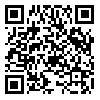Volume 14, Issue 3 (Occupational Medicine Quarterly Journal 2022)
tkj 2022, 14(3): 74-85 |
Back to browse issues page
Research code: A-10-1844-2
Ethics code: IR.BMSU.REC.1400.044
Clinical trials code: A-10-1844-2
Download citation:
BibTeX | RIS | EndNote | Medlars | ProCite | Reference Manager | RefWorks
Send citation to:



BibTeX | RIS | EndNote | Medlars | ProCite | Reference Manager | RefWorks
Send citation to:
jannaty R, haghi S, jannaty H, jannaty L, pargar F, alidoust M. Risk assessment of resilience engineering level and integrated resilience engineering with safety, health and environment of hospitals (case study: two selected hospitals of Faraja in 1400). tkj 2022; 14 (3) :74-85
URL: http://tkj.ssu.ac.ir/article-1-1170-en.html
URL: http://tkj.ssu.ac.ir/article-1-1170-en.html
Bachelor of Occupational Health Engineering, Police Trauma Research Center, Deputy Health, Relief and Treatment, Police Force, Tehran, Iran , rasouljannaty@gmail.com
Abstract: (1569 Views)
Introduction: By evaluating the level of resilience engineering and resilience engineering combined with safety, health, and environment, the priorities of medical centers to face crises are determined. Therefore, this study aimed to implement a risk assessment model with a checklist designed in a fuzzy environment.
Materials and Methods: This cross-sectional study, in 2014, in two Faraja hospitals in Iran, using two risk assessment forms including seven resilience indicators (24 sub-indices) and three integrated resilience indicators with safety, health, and environment (8 sub-index) was done that the final risk level in each index was calculated with trapezoidal fuzzy numbers in the fuzzy environment and multiplied by the weight of each expert. Based on this, the priorities of each hospital were determined.
Results: In the evaluation results, it was found that in the first hospital, management commitment and transparency, and in the second hospital, flexibility are the main priorities. In both hospitals, management commitment in HSE, knowledge in HSE, and learning culture in HSE were RE-HSE priorities, respectively.
Conclusion: Based on these results, it is suggested to focus on all the parameters, especially the parameters related to management commitment indicators, transparency and flexibility in RE, and management commitment in HSE.
Materials and Methods: This cross-sectional study, in 2014, in two Faraja hospitals in Iran, using two risk assessment forms including seven resilience indicators (24 sub-indices) and three integrated resilience indicators with safety, health, and environment (8 sub-index) was done that the final risk level in each index was calculated with trapezoidal fuzzy numbers in the fuzzy environment and multiplied by the weight of each expert. Based on this, the priorities of each hospital were determined.
Results: In the evaluation results, it was found that in the first hospital, management commitment and transparency, and in the second hospital, flexibility are the main priorities. In both hospitals, management commitment in HSE, knowledge in HSE, and learning culture in HSE were RE-HSE priorities, respectively.
Conclusion: Based on these results, it is suggested to focus on all the parameters, especially the parameters related to management commitment indicators, transparency and flexibility in RE, and management commitment in HSE.
Type of Study: Research |
Subject:
Safety and occupational accidents
Received: 2021/12/19 | Accepted: 2022/11/17 | Published: 2022/12/6
Received: 2021/12/19 | Accepted: 2022/11/17 | Published: 2022/12/6
Send email to the article author
| Rights and permissions | |
 |
This work is licensed under a Creative Commons Attribution-NonCommercial 4.0 International License. |







